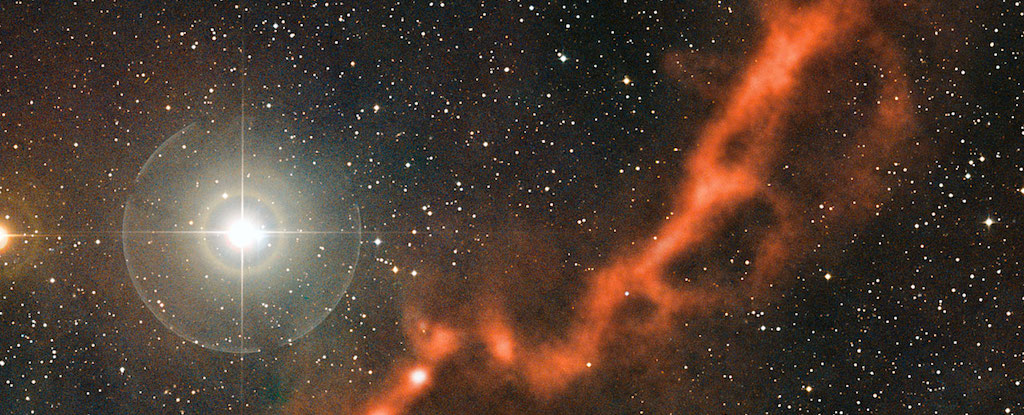
a view of the Taurus Molecular Cloud, as seen from the APEX radio telescope in Chile
While details are understandably slim today, life on Earth is thought to have arisen about 4 billion years ago from a fateful blend of organic compounds popularly known as primordial soup.
Just how – and where – the ingredients for this proto-biological entree were generated is still a field of debate, given the timeline and surface conditions on a cooling baby Earth.
Crucial materials like amino acids, lipids, and sugars can form in the depths of space, as recent research has shown, and have been delivered to the early Earth via meteorites and comets.
According to a new study by a team from Germany and France, that scenario is not only plausible, but offers the most likely explanation for how Earth obtained certain building blocks of life, some of which would have formed more efficiently in interstellar space.
The study focuses specifically on the formation of peptides, or short chains of between 2 and 50 amino acids linked by chemical connections called peptide bonds.
Peptides are key to life on Earth. Formed out of unique sequences of amino acids, they serve diverse functions such as catalyzing an array of biological processes. Ancient peptides might also have played a role in creating the primitive precursors of cell membranes, the authors note.
Yet despite peptides’ apparent importance in enabling life on Earth, the young planet probably didn’t offer a great environment for their formation, the researchers add.
Water can have a confounding effect on the formation of peptides from chemical components, they explain, and thus might have hindered that part of abiogenesis, or the emergence of life from nonliving materials.
There is surprisingly friendlier place for peptide formation: the interstellar medium, a term for the sparse matter and radiation occupying vast expanses of space between star systems.
Led by Serge Krasnokutski, an astrophysicist at the Max Planck Institute for Astronomy in Germany, the study’s authors simulated conditions found in the interstellar medium, allowing them to test in a laboratory some key details about how our planet might have ended up with peptides.

A view of the Orion B molecular cloud from the Hubble Space Telescope. ( NASA/ESA )
They confirmed, for instance, that peptide synthesis depends on three chemical ingredients – carbon, carbon monoxide, and ammonia – the presence of which can spark the formation of amino acid-like aminoketene molecules in low-density interstellar dust clouds.
As this kind of molecular cloud condenses, its dust particles begin to coagulate, the researchers note, and the aminoketene molecules can assemble into chains – i.e., peptides.
Ongoing coagulation of dust particles in interstellar space can help transform a thin molecular cloud into a denser protoplanetary disk, the ring of debris around a star that eventually condenses further to form planets, moons, and other celestial bodies.
Within these circumstellar disks, comets or asteroids with large separations from their star are “the most interesting objects for the formation of peptides,” the researchers write.
As such an object approaches a star and warms up, evaporation of its interior molecules is generally suppressed, and only molecules from a thin surface layer can freely evaporate.
Once the object’s temperature rises to 176 Kelvin, ammonia in its molecular ice combines with water to form a mixture which has a melting point lower than those of its constituents. Largely unable to evaporate, the liquified contents deep within the comet or asteroid could be “nicely suited” for the formation of aminoketene molecules, the study’s authors write.
Solid molecules can move around more freely within this liquid state, they note, allowing for a high concentration of ammonia molecules to serve as catalysts.
Also, since rapid warming can derail the formation of peptide bonds, the long timescales at which these celestial objects undergo temperature changes is more likely to support peptide synthesis, providing more time for the necessary chemical reactions to occur.
Peptides likely formed this way as our own Solar System developed, the authors suggest, and may have later reached Earth as the young planet was bombarded by meteorites, comets, and other potentially peptide-bearing objects.
The arrival of peptides would have given Earth at least one critical component for life, contributing to the development of protomembranes, or the precursors of membranes that give cells their structure and corral their contents.
More research will be needed to explore these findings, and to continue filling in gaps in our understanding of life’s origins, but the authors say this study adds substantial support for the idea that extraterrestrial ingredients helped bring Earth’s primordial soup to life.
The study was published in Science Advances.
News Related-
High court unanimously ruled indefinite detention was unlawful while backing preventive regime
-
Cheika set for contract extension as another Wallabies head coaching candidate slips by
-
Analysis-West's de-risking starts to bite China's prospects
-
'Beyond a joke' Labor won't ensure PTSD protections: MP
-
Formula One season driver ratings: Lando Norris shines as Max Verstappen nears perfection
-
Catalina golfer Tony Riches scores Guinness World Record four holes in one on same hole
-
Florida coach Billy Napier fires assistants Sean Spencer, Corey Raymond with expected staff shakeup ahead
-
Rohingyan refugee NZYQ accidentally named in documents published by high court
-
Colorado loses commitments of 2 more high school recruits
-
Queensland Health issues urgent patient safety alert over national bacteria outbreak
-
Townsville Community Pantry 'distressed' by fruit, vegetable waste at Aldi supermarket
-
What Is The Beaver Moon And What Does It Mean For You?
-
Labor senator Pat Dodson to resign from politics due to health issues
-
Hamas releases 11 more hostages, as Israel agrees to extend ceasefire
